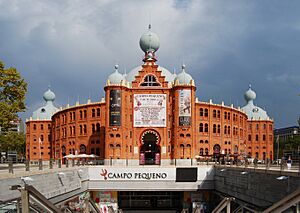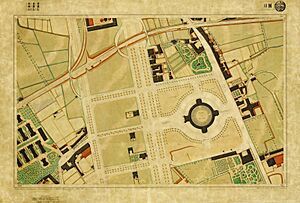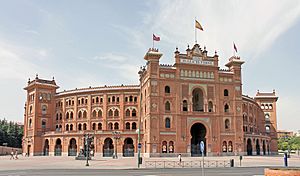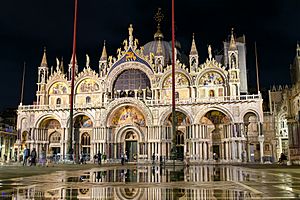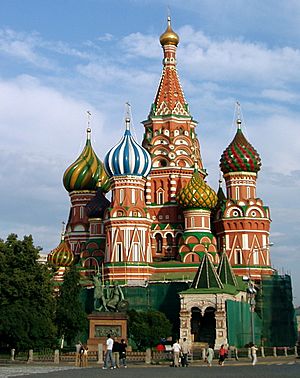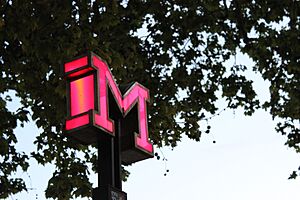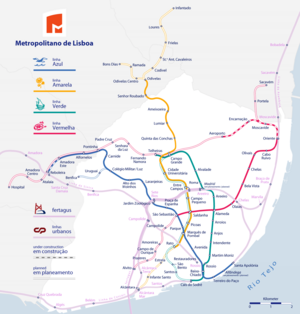Campo Pequeno Bullring facts for kids
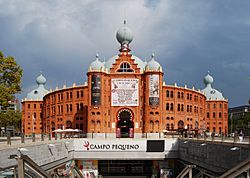
Exterior of the venue
|
|
| Location | Lisbon, Portugal |
|---|---|
| Coordinates | 38°44′33″N 9°8′43″W / 38.74250°N 9.14528°W |
| Type | Bullring |
| Capacity | 6,848 (bullfighting) 10,000 (concerts) |
| Construction | |
| Broke ground | 1890 |
| Opened | 1892 |
| Renovated | 2006 |
| Architect | António José Dias da Silva |
The Campo Pequeno Bullring (which means "Small Field Bullring" in Portuguese) is a famous building in Lisbon, Portugal. It's located on Avenida da República.
This special place is used for many different events. You can see traditional bull races here. It also hosts exciting musical concerts, fun fairs, interesting exhibitions, and other big events. The building can hold about 10,000 people for concerts, and has 6,848 seats for bullfighting. Bullfighting events usually happen in the spring and summer months.
Contents
A Look Back in Time: The History of Campo Pequeno
For a long time, people have seen bulls as powerful animals. They represent strength, courage, and even good luck. Because of this, fighting bulls became a way for people to show their own bravery. Kings and important people often enjoyed watching or even taking part in these events.
In the 1500s, King Sebastian of Portugal ordered the first known bullring in Lisbon. Over the years, other bullrings were built in different parts of the city. The area where Campo Pequeno stands today was first used for bull races in 1741. Back then, it was just a small wooden ring.
The current Campo Pequeno Bullring replaced an older one called Campo de Santana. That old building was closed in 1888 because it was unsafe. So, in 1889, the city of Lisbon gave land to an organization called Casa Pia. Casa Pia is still in charge of organizing bull races in Lisbon. A group of investors paid to build the new arena. It cost a lot of money, about 161,200$000 réis (an old Portuguese currency). The new bullring opened its doors in 1892. Today, it is recognized as an important historical building.
Campo Pequeno in the 21st Century
The Campo Pequeno Bullring was built with strong, visible brick. It was inspired by the bullfight arena in Madrid, Spain, and has a beautiful neo-Arabic style. In the early 2000s, the bullring got a big makeover. It was reopened in 2006.
One of the biggest changes was adding a special removable roof. This roof allows the arena to be used all year round, no matter the weather. It makes Campo Pequeno a very flexible space for many different events. The famous Portuguese bullfighter Rui Bento Vasques has been in charge of the bullfighting events since the renovation.
Below the arena, there's a modern shopping center called Campo Pequeno shopping centre. You can also find bars and restaurants on the ground floor. In 2019, new owners took over the arena. Businessman Álvaro Covões, who organizes concerts, and the Horizon fund now manage this historic venue.
Exploring the Campo Pequeno Museum
The Campo Pequeno Museum reopened in 2015. It's a place where you can learn all about the history of Portuguese bullfighting. The museum displays old items and new donations from famous bullfighters.
Its main goal is to keep the traditions of Portuguese bullfighting alive. It also helps people understand the culture behind it. The museum wants to show how important this heritage is. Between 2015 and early 2016, over 11,000 people from 94 different countries visited the museum. Most visitors were from Portugal and France, but people came from all over the world!
The Amazing Architecture of Campo Pequeno
The design of Campo Pequeno was part of a bigger plan to improve Lisbon in the late 1800s. The city wanted to grow north and create new, wide avenues. This project aimed to make Lisbon a more modern and exciting city. Campo Pequeno was chosen for the bullring because there had been a simpler wooden one there before.
Before this big plan, Campo Pequeno was mostly a rural area with farms. But the new city plan changed everything. Today, Campo Pequeno is much more than just a bullring. It's a lively city square with gardens, shops, offices, and homes. It's a busy and important part of Lisbon life.
Design of the Bullfight Ring
The first ideas for the bullring's design came from the Madrid bullring, with its beautiful neo-Mudéjar style. This means it has an Arabic-inspired look. The main architect was António José Dias da Silva. He worked with others to create this unique building.
The bullring is mostly made of brick, but it also uses metal for its domes. This gave it a modern look for its time. The domes were inspired by different styles, including Byzantine, Russian, and Indo-Islamic architecture. They even look a bit like St Mark's Basilica in Venice and St. Basil's Cathedral in Moscow!
The building is circular with several towers on the outside. These towers and arches give it a very distinct neo-Moorish feel. Inside, the arena can be changed with its removable roof. Campo Pequeno is a great example of the neo-Arabic style in Lisbon from the late 1800s. Its unique design helped attract people and make Lisbon a more exciting city.
Discovering Lisbon with Geotourism
Geotourism is a special kind of travel. It focuses on exploring the natural geology of a place, like its rocks and landforms. It's a way to learn about the Earth's history in a fun and interesting way. This type of tourism often attracts people who want a unique and less crowded travel experience.
Even in a city like Lisbon, you can find amazing geological stories. Lisbon is famous for its seven hills, which are a great example of its unique landscape. The city's buildings and metro stations also show off beautiful natural stones.
The Lisbon subway has four lines: Green, Red, Blue, and Yellow. The Yellow Line, where Campo Pequeno station is located, is sometimes called the "Stone Line." This is because three of its stations – Campo Pequeno, Saldanha, and Entrecampos – are famous for their beautiful stone artwork. At Campo Pequeno station, you can see amazing designs and patterns made from different types of stone. It's like a hidden art gallery underground!
See also
 In Spanish: Plaza de toros de Campo Pequeno para niños
In Spanish: Plaza de toros de Campo Pequeno para niños
- Portuguese-style bullfighting


